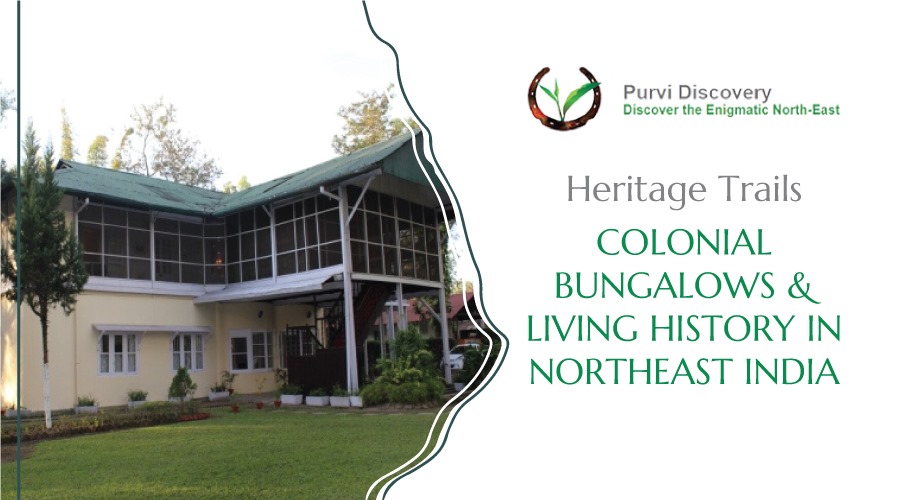Colonial Bungalows Living History in Northeast India
In a forgotten corner of the world, where tea leaves rustle softly in the morning breeze and the hills roll out in quiet green waves, time hasn’t just passed — it has settled. The verandahs here are wide and slow. The air smells faintly of damp earth and old wood. Somewhere, a kettle whistles. You aren’t in a hotel. You are inside a memory.
This is Northeast India, a place where heritage lingers — not behind glass cases or velvet ropes, but in the homes still lived in, in the stories still told, and in the rituals of everyday life. The colonial past and indigenous present exist here side by side, not in tension, but in gentle conversation.
The Bungalows That Remember
Long before boutique hotels and wellness retreats, there were the bungalows. Built by British tea planters in the 1800s and early 1900s, these homes weren’t just shelters — they were statements. Of order in the midst of wildness. Of familiarity in foreign soil.
And yet, over the decades, these structures have taken on a character of their own — no longer colonial outposts, but living spaces soaked in Assamese sun, flavored by tribal cookfires, softened by time.
Staying in one of these bungalows — like the Mancotta Heritage Bungalow in Dibrugarh — isn’t about luxury in the modern sense. There’s no marble, no butlers in gloves. What you find instead is something quieter and rarer: wide four-poster beds that creak like old songs, cane furniture that once held secrets, a verandah view that hasn’t changed in a century.
Here, with Purvi Discovery, you don’t simply book a room — you are invited into a living archive.
A Different Kind of Storytelling
Travel in the Northeast is not hurried. It is not loud. It unfolds like a novel — chapter by chapter, page by page.
One morning, you’re seated at a breakfast table once used by a tea estate director in the 1930s, butter melting on toast, birdsong weaving in and out of your thoughts. Later, you walk through the plantation, guided by someone whose family has worked this land for generations — someone who knows not just how tea is picked, but when the wind changes and why the sky darkens just before the monsoon comes.
In the evenings, you may find yourself sipping Assam’s famed second flush on a softly lit verandah, as a local musician plays a bamboo flute. And in the silence between notes, history breathes.
Beyond the Estates: Heritage in the Everyday
But heritage in Northeast India isn’t limited to the architecture of its tea estates. It lives in the weavers of Majuli Island, whose looms still echo with ancestral rhythms. It hides in the bamboo homes of Nagaland’s Konyak elders, their walls lined with stories and ceremonial headgear. It rises with the chants of monks at Tawang Monastery, a place older than the borders that now frame it.
Everywhere, the past is alive. Not frozen, not fixed. Simply… present.
And with Purvi Discovery, these moments are not performances — they are encounters. Carefully arranged, yes. Respectfully curated. But never forced. Always real. The Luxury of Time and Place
There’s a certain kind of traveler who understands this. One who isn’t looking to be entertained, but to be enriched. One who values privacy, not isolation. Simplicity, not austerity. Presence, not spectacle.
For that traveler, Northeast India offers something rare in today’s world: a sense of timelessness, paired with the refinement of meaningful hospitality.
Yes, you’ll be comfortable. The sheets will be soft. The food — a blend of Anglo-Indian heritage and local tradition — will be prepared with care. But more than anything, you’ll remember the feeling of having stepped into a place that remembers you, too.
A Journey to Carry With You
Not all heritage is grand. Sometimes, it’s the way tea is served. The way an old map folds. The way a path through a bamboo grove feels beneath your feet.
Traveling through Northeast India with Purvi Discovery is a chance to walk that path — slowly, thoughtfully, and with all your senses open.
You don’t just see history here. You sit with it. Sleep in it. Sip it slowly, like the tea you didn’t know you needed.
Explore your heritage journey through Northeast India
